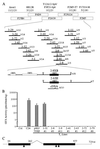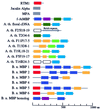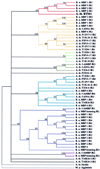Cloning of the Arabidopsis RTM1 gene, which controls restriction of long-distance movement of tobacco etch virus
- PMID: 10618445
- PMCID: PMC26690
- DOI: 10.1073/pnas.97.1.489
Cloning of the Arabidopsis RTM1 gene, which controls restriction of long-distance movement of tobacco etch virus
Abstract
The locus RTM1 is necessary for restriction of long-distance movement of tobacco etch virus in Arabidopsis thaliana without causing a hypersensitive response or inducing systemic acquired resistance. The RTM1 gene was isolated by map-based cloning. The deduced gene product is similar to the alpha-chain of the Artocarpus integrifolia lectin, jacalin, and to several proteins that contain multiple repeats of a jacalin-like sequence. These proteins comprise a family with members containing modular organizations of one or more jacalin repeat units and are implicated in defense against viruses, fungi, and insects.
Figures





References
-
- Staskawicz B J, Ausubel F M, Baker B J, Ellis J G, Jones J D. Science. 1995;268:661–667. - PubMed
-
- Whitham S, Dinesh-Kumar S P, Choi D, Hehl R, Corr C, Baker B. Cell. 1994;78:1101–1115. - PubMed
-
- Hammond-Kosack K E, Jones J D G. Annu Rev Plant Physiol Plant Mol Biol. 1997;48:575–607. - PubMed
-
- Callaway A, Liu W, Andrianov V, Stenzler L, Zhao J, Wettlaufer S, Jayakumar P, Howell S H. Mol Plant Microbe Interact. 1996;9:810–818. - PubMed
Publication types
MeSH terms
Substances
Associated data
- Actions
Grants and funding
LinkOut - more resources
Full Text Sources
Other Literature Sources
Molecular Biology Databases

